Every organization has an ‘open kitchen’ due to digital customer service
A restaurant chef, working in an open kitchen has to think twice about the ‘3-second rule’ when it comes to fallen food. Did a piece of food fall on the floor? You won’t be putting that on a plate anymore. Within many organizations, mistakes are not being dealt with adequately. Even due to social media, all organizations are operating with an open kitchen nowadays. In this blog, I will share five trends that are having the most impact in the world of customer service.
Understanding trends = understanding customer behavior
Understanding the trends will help to understand and to influence the behavior and expectations of the customer. Better choices can be made when managing the customer expectations of your organization. This is crucial, as more than 60% of the customers state that customer service impacts loyalty towards a brand, says Microsoft research.
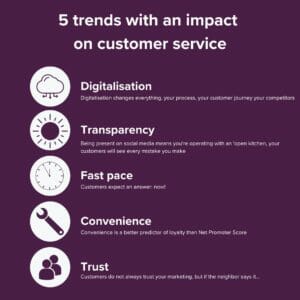
Trend 1: Digitalizing the customer experience
Digitalization has an enormous impact on customer service. As almost everything has become digitalized, not only processes are changing, but also the wishes and needs of your clients. Next to that, the starting and ending point of the customer journey is changing.
Customers are increasingly expecting that your organization can be reached through multiple digital channels. Consumers over 60 years old are still having a preference for personal communication through the phone, and a less preferred need to communicate through email. Consumers below 25 years of age have 35% preference for contact through social media.
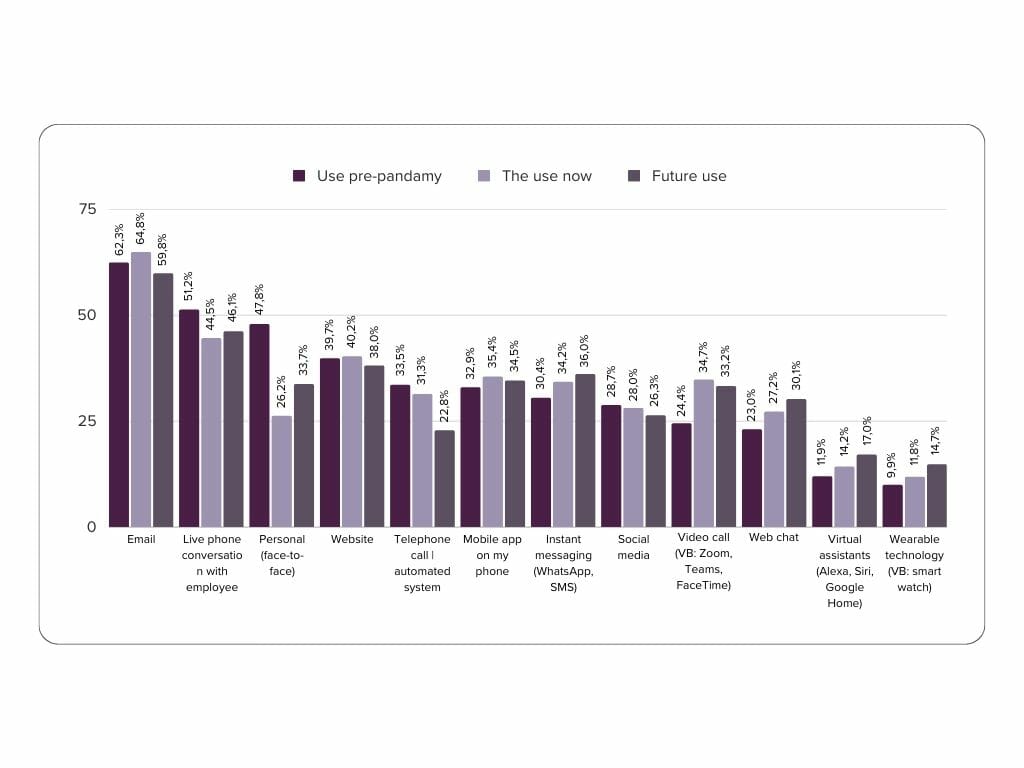
A part of the younger consumers even has an aversion to contact through the phone. 42% of Gen Y claim to prefer to clean a toilet, instead of calling customer service (Aspect Software, 2017).
42% of the consumers from Gen Y prefers to clean a toilet, than to make a phone call to Customer Service.
Aspect Software, 2017
Microsoft researched that around 60% of the customer service journey starts online. It seems quite logical to offer customer support through Whatsapp, chat or social media. In fact, it is not only logical, but it leads to more satisfaction as well.
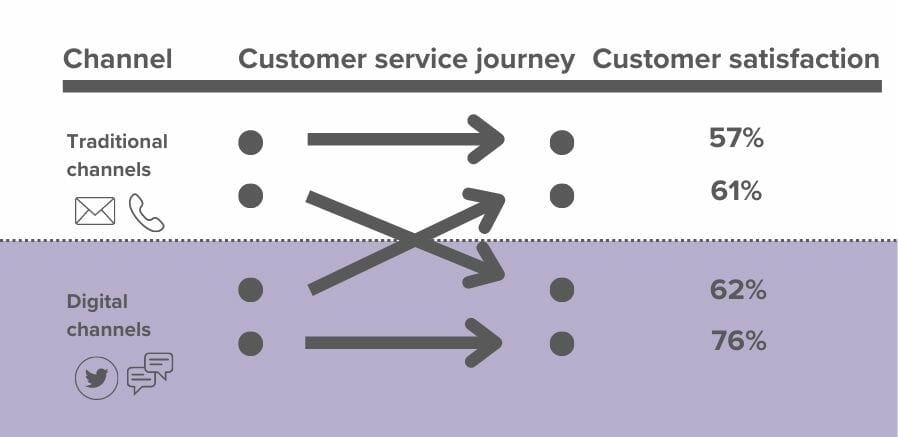
Source: Digital Marketing; Recall no 22; higher satisfaction at lower cost. Digitizing customer Care
Customers seem to be the most satisfied when they can both start and end their journey through online channels. The average satisfaction increases by 15% if clients do not have to switch to analogical channels when starting their customer journey online. Completely analog finished service contact lead, on average, to lower satisfaction.
Does this mean that you should only offer digital channels? Not at all. But, make sure that you invest in your online customer journey to increase customer satisfaction.
Trend 2: Transparency
With social media, your service becomes like an open kitchen. Customers will see when you ‘drop a piece of food’.
Consumers are getting more and more insights into the functioning of organizations. Through reviews and posts on social media, they will create their own thoughts about an organization. This information has an impact on whether someone wants to become a client, or wants to remain a client.
A cook in a restaurant will think twice if he dropped a piece of food. He won’t put it back on the plate.
The comparison between social customer service and an open kitchen in a restaurant shows the impact and importance of transparency.
Openness through Social Media and reviews
Customers are sharing their experiences on social media channels such as Twitter and Facebook and on review sites such as Google Reviews and Trustpilot. A quick peek at messages of your clients on Twitter or reading the last 10 reviews gives a good insight into what goes wrong within your organization. Clients understand ‘where a piece of food had been dropped’. Not responding directly and honestly may result in an even worse situation. Be honest about what goes wrong in your organization and try to solve complaints as quickly as possible. But even more important: make sure that you ‘don’t drop a piece of food on the floor’ that often.
Tip: plan a few minutes every week to look at your organization from the outside by checking the reviews and social media messages about your organization.
Trend 3: Fast pace service
Customers are expecting an answer: Now!
Customers are expecting an answer faster than ever from organizations. And may that be the cause for the attendance of digital customer service. But also the consequence. Responding too late is already a reason to look for another organization.
Fast, faster, fastest
17% of consumers expect a response within an hour through social media contact. One-third of clients expect an answer within an hour if they have reached out through email (research by Toister Solutions). The next question is how big the difference is between expectations from the client and the actual response time.
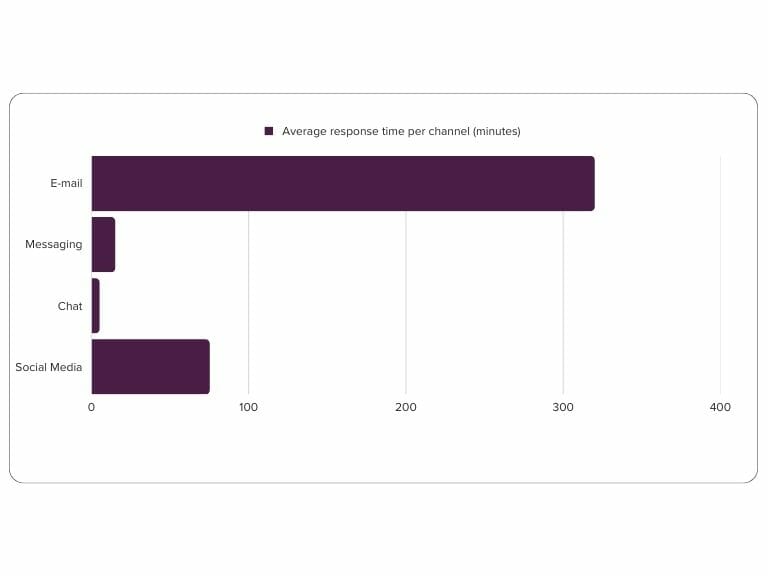
Source: Dimension Data; 2019 Global Customer Experience Benchmarking Report; paragraaf 2.8
On average, companies respond within 5.5 hours to questions that have been sent through email. For social media, a response can be expected within an hour, and for Messaging within 15 minutes.
The introduction of bots creates expectations for speed
Research from Nice shows that organizations are underestimating customer satisfaction through human channels such as telephone communication. But they do think too well about the satisfaction of self-service channels such as chatbots. Even though their dissatisfaction about chatbots, it is hard to imagine that no company will make use of chatbots in 2025. In 2017, around 2% of organizations already made use of a chatbot. With the emerging technology of Artificial Intelligence, chatbots and of course ChatGPT, customers experience even more an answer within a second. This leads to increasing expectations when it comes to fast-paced answers.
Tip: Do not aim to reply to service contacts as soon as possible, but try to make a distinction between the different topics and decide upon a list of priorities: which topic to answer first.
Trend 4: Ease of service
Convenience is a better predictor of loyalty than Net Promoter Score.
Consumers do not have the patience anymore for complex products and services. Think of receiving the same info multiple times, and inconsistent opening times. Because we are getting used to more convenient services, our expectations keep on increasing.
Exceeding clients’ expectations: one of the main goals of organizations when it comes to customer focus. But the question is, is that the right way of thinking when it comes to service? Is exceeding client expectations achievable in the long term? Or even in the short term?
Convenience does have an impact on customer loyalty
Reserach in the Harvard Business Review shows that exceeding client expectations does not improve customer loyalty. However, the effor that a client has to put into receiving an answer to a question does have impact on the loyalty. Convenience is an important quality indicator. Consumers want to have a straight forward answer to their questions, an easy fix for their problem, or just simply transfer money. Improving convenience for your service leads to less client contact, but can be handled even faster. Simply said: focus on convenience for happy, loyal customers that will cost you less.
If you focus on cost, quality goes down. If you focus on quality, cost goes down.
70% of the respondents in the Dimension Data benchmark 2019 state that convenience is one of the three most important factors that has an influence on customer satisfaction.
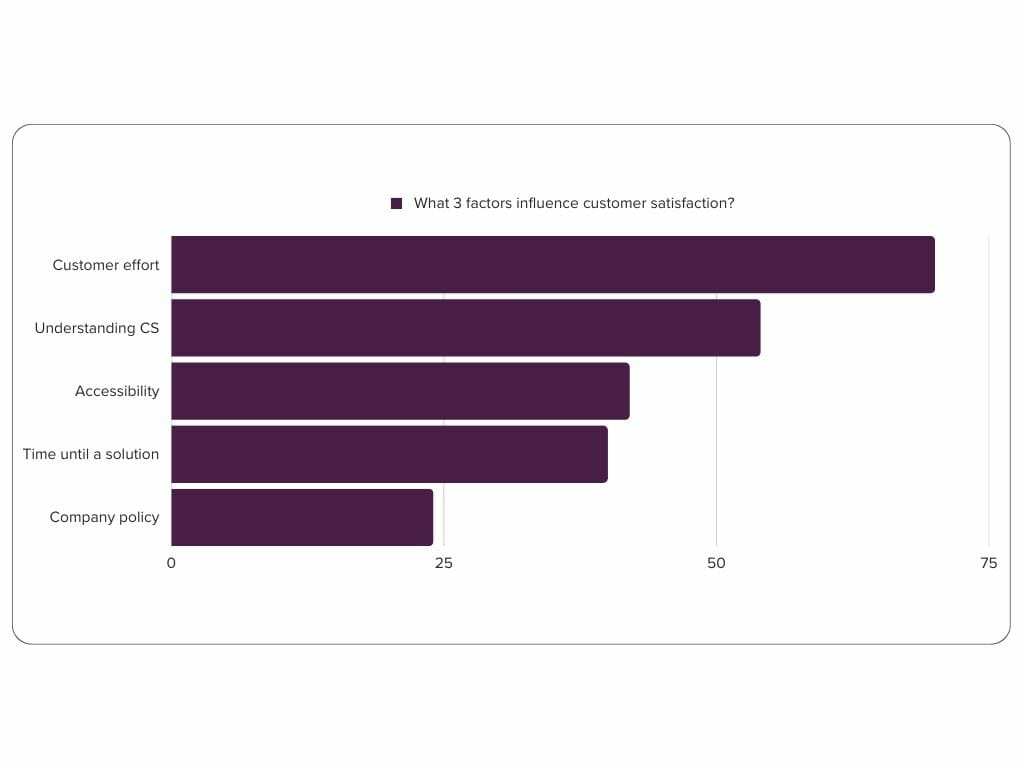
Tip: make sure to measure the Customer Effort Score (CES) within your organization.Try to document the outcomes on the process level so you know where you need improvement.
Trend 5: Trust
Customers do not always trust your marketing, but if the neighbor says it…
Consumers do not have all the trust in organizations. In 2019, 60% of Dutch respondents said that they have trust in organizations (Edelman trust barometer). Even though that seems like they have more trust in organizations than in the government or media, we tend to look with a little suspiciousness to marketing messages from organizations.
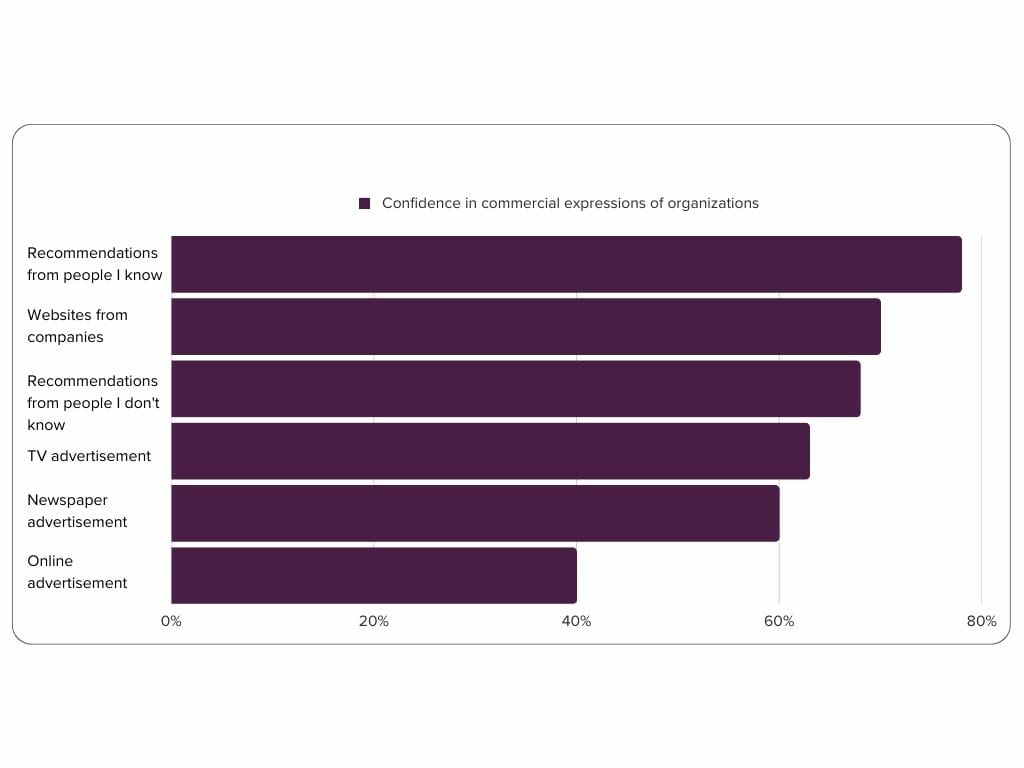
The future customers of your organization are not easy to reach with your marketing messages. Though, they tend to trust recommendations from friends and family. This shows the urgency to invest in a fast pace, convenience, transparency and digitalization.
Tip: Do you want your current customers to let them recommend your organization to their friends and family? Do not trust on your marketing, but make sure you provide a good and trustful service.
Impact of trends on customer experience
These trends have an impact on what your clients expect of your organization. But there is another influence on how high that bar is set.
Your competitors are active in the same industry, of course. May you have a holiday resort, be an application developer or work in the construction scene. When it comes to deciding upon expectations of your client, businesses outside of your industry are becoming even more relevant.
Who decides what your customers expect from your organization?
The expectations of your client are being set by world leaders when it comes to customer orientation. Based on the experience your clients had with e.g. KLM and Apple, a day prior to their visit to your organization. These businesses are setting the bar when it comes to how long a client is willing to wait for an answer, which communication channels they want to use and what can be expected in terms of customer service These businesses determine whether clients will leave your business or if they become fans.
Customer contact satisfaction shows a downward trend over the past few years. That seems logical, as the combination of the above mentioned 5 trends and the increasing client expectations based on previous customer contact experiences with the top world leaders.
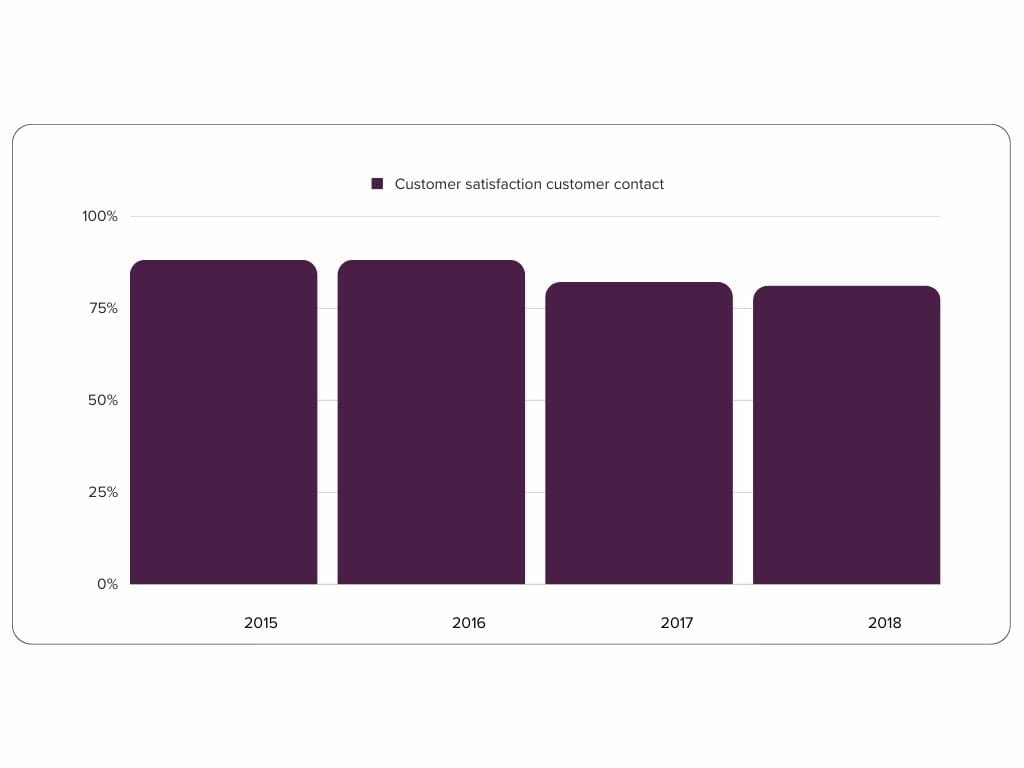
It is of crucial importance to make smart moves with your organization in order to reach an optimal customer satisfaction. In that way, they will share their experience with their neighbor.





